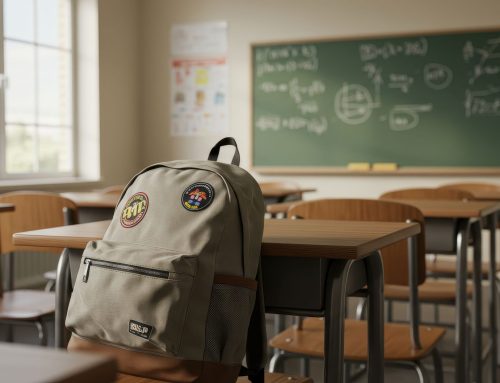What happens to children’s academic skills over summer break? Research shows that many students lose ground, an effect known as the ‘summer slide.’
Several studies conducted in the 1970s and 1980s appeared to show that children suffered significant learning losses during the summer months. “The most famous study regarding summer learning loss… [was] the Beginning School Study, which started in the fall of 1982 with 838 first graders in the Baltimore City Public Schools. Students were tested twice a year, in fall and spring, so researchers could tell how quickly they were learning during the school year and during summer vacation.”
“At the beginning of the study, first graders in high-poverty schools scored 16 points below other first graders on the California Achievement Test… The gap more than tripled, to 56 points, by the end of eighth grade. Remarkably, all the gap growth occurred during summer vacations; gaps did not grow during the school years. This is where we got the idea that more than two-thirds of the eighth-grade achievement gap comes from summer learning loss” (Von Hippel, 2019). As a result, “a fruitful stream of intervention research was catalyzed to test the effects of improving access to summer programs and resources” (Lynch et al., 2025).
Recently, summer learning has been in the spotlight again due to the learning disruptions caused by the COVID-19 pandemic. “Summer programs have emerged as one of the most popular recovery strategies offered by school districts, with an estimated $5.8 billion of Elementary and Secondary School Emergency Relief Fund (ESSER) resources expected to be spent on summer programs by September 2024” (Kuhfeld & McEachin, 2024).
However, several recent studies on “summer learning loss” have called into question past research findings. For example, a study by Von Hippel and Hamrock (2019) examined “measurement artifacts” (errors or distortions in the results that come from the way something is measured) concerning the growth of test score gaps… before, during, or between the school years. In addition, studies by NWEA researchers found that “Gaps between students attending low- and high-poverty schools do not consistently widen during the summer… and that differences between Black and white students hold steady or narrow during the summer” (Kuhfeld & McEachin, 2024).
To make the issue even more confusing, the same researchers reported the following results for studies using the ECLS-K, MAP Growth, Star, and i-Ready assessments:
- On average, test scores tend to flatten or drop during the summer, with larger declines typically observed in math compared to reading.
- Research using interim and diagnostic assessments – MAP, Star, and i-Ready – has found far larger summer drops across a range of grade levels.
- Conversely, studies using test scores from ECLS-K:2011 showed that student learning slows down but does not drop over the summers after kindergarten and first grade.
Comparison of Summer Slide Estimates Across Four Assessments (Kuhfeld & McEachin, 2024)

Kuhfeld, M. & McEachin, A. (2024) concluded that “Given the sizable differences in the magnitude of test score drops across tests, it remains uncertain whether summer slide should be considered a trivial issue or a serious educational challenge.” Earlier, Kuhfeld (2019) wrote, “The field cannot really explain why differences in students’ summer learning occur.”
Educators Must Be Expert Consumers
At this point, the reader’s head is probably spinning. While asking questions and testing theories are important, educational research often results in confusion rather than clarity. That’s why educators must not only be skilled practitioners, but also expert consumers of research—able to analyze, question, and apply findings with a critical eye. Being an informed consumer means knowing how to recognize strong evidence, spot potential biases or flaws, and avoid jumping to conclusions based on headlines or incomplete data. When results are contradictory, educators must step back, realistically revisit past and present practices, and reconsider their understanding of basic learning principles. Unfortunately, however, research shows that most school leaders use evidence in a “superficial manner, leading to weak interpretation and limited understanding of underlying problems and available solutions” (Finnigan, 2013).
Fundamental Learning Principles
So, what are the clear-minded beliefs regarding summer learning loss (and, more generally, beyond-school-hours learning)? The Hall of Fame football coach Vince Lombardi is often quoted as having said that, “Practice does not make perfect, only perfect practice makes perfect.” However, in reality, most teachers and coaches emphasize approximations of perfection. No gymnast, ballerina, skater, foul-shooter, pianist, speaker, speller, writer, or reader performs tasks perfectly on the first try or the first dozens of tries. In reality, it is deliberate practice, not perfection, that is critical (Macnamara, 2016).
What Now?
Summer programs have the potential to provide the social, emotional, and academic support many children need. However, research suggests that several challenges must be overcome for summer initiatives to be successful. On the positive side, nearly 100% of urban public-school districts offer summer programs, and more than 90% offer academic programs (Rand, 2023). Conversely, in addition to funding limitations, obstacles include difficulties in recruiting the students who are most in need of support. According to the National Center for Education Statistics (NCES), student participation nationwide in academically oriented summer programs was only about 15 percent (NCES, 2023). In addition, research has shown that districts face challenges in enlisting highly effective teachers to work during the summer months, and low student attendance rates (even after they have enrolled).
Some of the most comprehensive networks of summer programs were developed with funding assistance from the Wallace Foundation (2011–2017), and the National Summer Learning Project (NSLP) is an important source of data on the effectiveness and challenges of implementing summer programs. All the students in the NSLP (randomized controlled trial) study were in the third grade in the spring of 2013 and were enrolled in a public school in one of five urban districts: Boston, Dallas, Duval County (FL), Pittsburgh, and Rochester (RAND, 2023). The programs varied among the districts, but all districts agreed to offer full-day programming five days per week for a minimum of five weeks, with at least three hours of instruction in language arts and mathematics per day. The programs were free, and transportation and meals were provided.
However, the RAND studies found that attendance in summer programs was a significant challenge. In the first year of the study, 3,192 third-grade students were enrolled; however, 19% never attended (“no shows”), and 29% of the children had low attendance (i.e., between 1 and 19 days). The figure below shows the attendance data for the first two summers of the project. As can be seen, the rate of “no-shows” increased substantially in 2014. Almost half (48 percent) of the 3,192 students were “no-shows” in the second summer, including 11% who moved out of the district and 37% “no-shows” who could have attended since they remained in the district (RAND, 2016).
Screenshot 2025-06-26 at 12.09.57 AM

The authors speculated that “consistent summer attendance is inhibited by the following:
- A prevailing attitude that summer programs should be and are more relaxed than the school year, allowing for dropping in and out of the summer session.
- The need for students to care for younger siblings at home.
- Changes to family plans and vacations.
- Dislike of the program, which could be related to bullying and fighting among students.
- Competing opportunities, in part, related to the activities of friends and neighbors (who were not in the program)” (RAND, 2016).
Realistic and Important Goals
In 2019, the National Academies of Sciences, Engineering, and Medicine released a report on summer experiences and their impact on the development and well-being of children and youth (National Academies of Sciences, Engineering, and Medicine, 2019). “One of the key recommendations in the report is for cities and counties to take a comprehensive, community-wide approach” (Wallace Foundation, 2021).
As the Wallace Foundation (2011-2017) “wound down” the National Summer Learning Project (NSLP), some of the districts (and their partners) established “regional networks working to expand opportunities for quality summer programming in their cities” (Wallace Foundation, 2021). These networks included a wide range of programs and support. Impressively, the programs in Boston, Pittsburgh, Dallas, and Washington, D.C. served nearly 60,000 youth in the summer of 2019. According to the Wallace report, “In these cities, several leaders—such as mayors; city council members; and school district, out-of-school time (OST) intermediary, library, and community-based organization (CBO) heads—recognized the general need to create, strengthen, and promote summer programming for children and youth from low-income families” (Wallace Foundation, 2021).
- The Boston After School & Beyond–led summer network expanded to serve 13,464 students and offered 160 programs, including “enrichment activities, such as sailing, robotics, reading, and outdoor activities.”
- In Dallas, the 2019 summer program included 700 community partner organizations and 2,735 programs (95 percent of which were free) serving 68,303 students (Edwards, 2019). “DCOL programs spanned a variety of topics such as coding and games, community action, designing and making, earth and science, media, numbers, performance, sports and wellness, storytelling, work and career, and zoology.”
- Pittsburgh’s Summer16 program served nearly 16,000 youth and “focused on academic support, arts and culture, career and workforce development, child development, civic engagement and social justice, college readiness, enrichment, health and wellness, leadership development, mentoring, STEM, community service, and sports.”
- The DC Summer Strong program served 5,000 students in the summer of 2019. It expanded to 74 programs, including “focus areas, such as academic support, arts, computer/technology, environmental education, graphic design, health, life skills, mentoring, sports, and STEM” (Wallace Foundation, 2021).
So, what do students need, and how should districts’ summer programs try to meet their needs? First and foremost, it must be accepted that many children do not want to spend their summer vacation attending school. Therefore, recruiting children to return to school in the summer for an additional 3-6 weeks for remedial programs (and expecting them to attend regularly) will be challenging, particularly for students lacking strong academic skills. So, summer school can not be just for remediation. To attract students, programs must be varied, as in the examples above. Furthermore, Catherine Augustine and Heather Schwartz (2022), lead researchers and authors of all seven RAND National Summer Learning Project reports, offer the following recommendations for developing and administering summer programs.
- Plan now. Comprehensive early planning reduces logistical problems and increases instructional time.
- Start developing the curriculum. Summer programs are short. Districts need to provide teachers with well-organized curricular materials that include lesson plans aligned with student needs.
- Promote consistent attendance. Students need to attend at high rates to demonstrably benefit from a summer program. The one factor that was correlated with attendance was site climate; programs with lower absenteeism had an inclusive and friendly environment, strong engagement, and positive interactions between adults and students.
- Build new skills and interests. Summer programs can offer activities such as swimming, field trips, theater, and cooking to expose students to new experiences and help them develop new skills. These activities can also support attendance goals, as students look forward to coming back each day.
- Hire the best teachers. Teacher quality has the largest school-based impact on student outcomes. Hiring certified academic teachers with relevant grade level and subject experience will enhance student learning.
————————
References:
Allington, R. L. (1980). Poor readers don’t get to read much in reading groups. Language Arts, 57(8), p. 872-876.
Anderson, R. C., Wilson, P. T., & Fielding, L. G. (1988). Growth in reading and how children spend their time outside of school. Reading research quarterly, 285-303.
Augustine, C. & Schwartz, H. (2022). The74. Analysis: Summer Learning Is More Popular than Ever. How to Make Sure Your District’s Program Is Effective.
Bryk, A. S., Gomez, L., Grunow, A., & LeMahieu, P. (2015). Learning to Improve: How America’s Schools Can Get Better at Getting Better. Harvard Education Publishing.
Cartwright, K.B., Marshall, T.R., & Wray, E. (2016). A Longitudinal Study of the Role of Reading Motivation in Primary Students’ Reading Comprehension: Implications for a Less Simple View of Reading. Reading Psychology, 37, 55 – 91.
Castles, A., Rastle, K., & Nation, K. (2018). Ending the Reading Wars: Reading Acquisition from Novice to Expert. Psychological Science in the Public Interest, 19(1), 5-51. https://doi.org/10.1177/1529100618772271 (Original work published 2018)
Durkin, D. (1984). Poor Black Children Who Are Successful Readers: An Investigation. Urban Education, 19(1), 53-76. https://doi.org/10.1177/004208598401900106 (Original work published 1984)
EdWeek (2023). Meisner, C. & Elizabeth Heubeck, E. Summer Schools Can Boost Learning, But Only If Students Attend. https://www.edweek.org/leadership/summer-schools-can-boost-learning-but-only-if-students-attend/2023/06
Finnigan, K., Daly, A., & Che, J. (2013). Systemwide Reform in Districts Under Pressure: The Role of Social Networks in Defining, Acquiring, and Diffusing Research Evidence. Journal of Educational Administration. ISSN: 0957-8234
Konrad, M.H. (2023). The Love of the Book: Students’ Text Selection and Their Motivation to Read. The Reading Teacher.
Kuhfeld, M. (2019. Rethinking Summer Slide: The More You Gain, The More You Lose.
Kappan. https://kappanonline.org/rethinking-summer-slide-the-more-you-gain-the-more-you-lose/.
Kuhfeld, M. & McEachin, A. (2024). Summer learning loss: What We Know and What We are Learning.
https://www.nwea.org/blog/2024/summer-learning-loss-what-we-know-what-were-learning/
Megan Kuhfeld, M., James Soland, J., Brennan Register, B., & Andrew McEachin A. (2023).
Testing an Explanation for Summer Learning Loss: Differential Examinee Effort Between Spring and Fall. Educational Evaluation and Policy Analysis, April 2023
Kuhfeld, M. & Lewis, K. (2023). Is Summer Learning Loss Real and Does it Widen Test Score Gaps by Family Income? Brookings.
Lynch, K., Lanteri, L., An, L., Mancenido, Z., & Richardson, J. (2025). The effects of summer learning on social-emotional and behavioral outcomes: A meta-analysis. Social and Emotional Learning: Research, Practice, and Policy Journal.
https://www.sciencedirect.com/science/article/pii/S2773233925000257
Macnamara, B. N., Moreau, D., & Hambrick, D. Z. (2016). The relationship between deliberate practice and performance in sports: A meta-analysis. Perspectives on Psychological Science, 11(3), 333-350.
Mol, S. E., & Bus, A. G. (2011). To read or not to read: A meta-analysis of print exposure from infancy to early adulthood. Psychological Bulletin, 137, 267–296. doi:10.1037/ a0021890
Morgan, P.L., & Fuchs, D. (2007). Is There a Bidirectional Relationship between Children’s Reading Skills and Reading Motivation? Exceptional Children, 73, 165 – 183.
National Academies of Sciences, Engineering, and Medicine, Shaping Summertime Experiences: Opportunities to Promote Healthy Development and Well-Being for Children and Youth (2019). Washington, D.C. National Academies Press.
https://www.nationalacademies.org/our-work/ summertime-experiences-and-child-and-adolescenteducation-health-and-safety
NCES (2023). National Center for Education Statistics, U.S. Department of Education’s Institute of Education Sciences (IES). The Majority of K-12 Public Schools Offer Academically-Focus Summer and After-School Programs.
RAND, (2023). Diliberti, M. & Schwartz, H.
School was in Session This Summer, but Less Than Half of Eligible Students Enrolled. Selected Findings from the Fall 2023 American School District Panel Survey. https://wallacefoundation.org/sites/default/files/2024-05/school-was-in-this-summer.pdf
RAND/Wallace Foundation (2016). Catherine H. Augustine, Jennifer Sloan McCombs, John F. Pane, Heather L. Schwartz, Jonathan Schweig, Andrew McEachin, Kyle Siler-Evans
Effects of Voluntary Summer Learning Programs on Low-Income Urban Youth. National Summer Learning Project.
Shea, G. (2020). Preventing the Summer Slide for Low-Income and English Learner Students. Proceedings of the 2020 AERA Annual Meeting.
Stanovich, K. E. (2017). Speculations on the causes and consequences of individual differences in early reading acquisition. In Reading acquisition (pp. 307-342). Routledge.
Von Hippel, P. (2019). Is Summer Learning Loss Real? How I lost faith in one of education research’s classic results. Education Next, 9-14
Von Hippel, P. & Hamrock, C. (2019). Do test score gaps grow before, during, or between the school years? Measurement Artifacts and What We Can Know in Spite of Them. Sociological Science, 6, p. 43–80.
https://www.educationnext.org/wp-content/uploads/2022/01/ednext_XIX_4_von_hippel.pdf
Walker, B. (2021). American Educational Research Association (AERA). How Testing Intervals Affect Summer Learning Loss Measurements. Online Paper Repository. https://doi.org/10.3102/169115
Wallace Foundation (2021). Catherine H. Augustine, Jennifer Sloan McCombs, Garrett Baker.
National Summer Learning Project. Building Coordinated Networks to Promote Access to Quality Summer Learning and Enrichment Opportunities Across a Community.
Weber, S. (2018). How Teachers Can Guide Library Book Selection to Maximize the Value of Independent Reading Time.
Willingham, D. T. (2017). The reading mind: A cognitive approach to understanding how the mind reads. San Francisco, CA: Jossey-Bass.
Wilson, W. (2014). Helping Parents, Helping Children: Two-Generation Mechanisms. https://futureofchildren.princeton.edu/sites/g/files/toruqf2411/files/media/helping_parents_helping_children_24_01_full_journal.pdf.
Wilson-Simmons, R., Jiang, Y., & Aratani, Y. (2017). Strong at the Broken Places: The Resiliency of Low-Income Parents. Policy Report.







